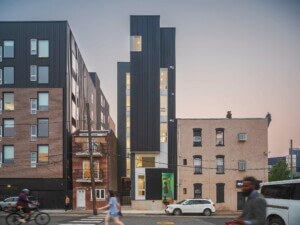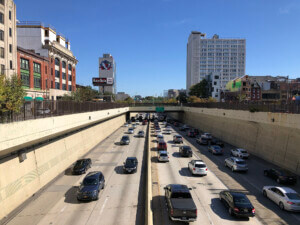University City, a neighborhood in central Philadelphia, on the Schuylkill River, is in for some major changes in the coming decades, thanks to a new redevelopment initiative from Amtrak with the Southeastern Pennsylvania Transportation Authority (SEPTA), BrandywineRealty Trust, and Drexel University. 30th Street Station will be the center point of the overhaul, which is part of a vision to build a dense urban neighborhood over a rail yard along the river.
The redevelopment site consists of a total of 175 acres in University City, 88 of which are occupied by the rail yard. The report and renderings released in the 30th Street Station District Plan are the culmination of a two-year study of the site, which extends east of Drexel’s campus, between Walnut and Spring Garden streets, and northeast from 30th Street Station.
The ambitious plan will be put into place over the course of 35 years, starting with capping off the existing Amtrak rail yard to accommodate a proposed 10 million square feet of development. The area will see a total of 18 million square feet of new development and will include housing for ten thousand residents. It will also offer 1.2 million square feet of commercial space to an individual corporate or institutional tenant.
Currently, 30th Street Station serves as one of the central hubs for Amtrak trains on the East Coast and is also a stop on the SEPTA Regional Rail line. The station building, along with the rail yard, is owned by Amtrak and was last renovated in 1991. One prominent feature of the station is the Pennsylvania Railroad World War II Memorial, a 28-foot bronze sculpture of Michael the archangel.
The project is expected to cost $6.5 billion, with $2 billion going to infrastructure investments and the other $4.5 billion to private investment. Among the infrastructure improvements may be the relocation of a ramp for the Schuylkill Expressway in favor of an intercity bus terminal. A new pedestrian plaza will surround the existing train station.
Preliminary renderings put emphasis on expanding parks and public spaces, as well as adding high-rise commercial and residential buildings to the area. According to the official report released by the district, an opportunity exists for the plaza around the station to become a “central civic space,” akin to the one at city hall. The station saw 11 million passengers last year, and the district expects ridership to double by 2040, following Amtrak and SEPTA improvements. The development counts on this ridership to anchor growth around the station.
The name University City was coined as a marketing tactic, in the 1950s, as part of a gentrification effort, to encourage faculty of the University of Pennsylvania and, to a lesser degree, Drexel University to move there.
This redevelopment isn’t the first sign of growth for the neighborhood. Much of University City is a designated “Keystone Innovation Zone,” a program started by the state of Pennsylvania to encourage start-up companies to populate Philadelphia. The program offers tax breaks of up to $100,000 annually for businesses younger than eight years old operating in the Innovation Zone. New companies in the science and research fields are also drawn to the incubator at the University City Science Center, which is in the process of a major expansion. According to a recent report, firms that were incubated at the Science Center bring $12.9 billion to the Greater Philadelphia economy each year.
Amtrak’s first steps are expected to be finalizing the design of the pedestrian plaza and receiving permission from PennDOT to relocate the highway ramp. More detail on the plan can be found here.










